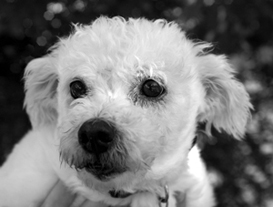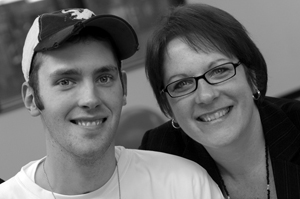"Pets of
Public Affairs":
The Inside Story
By Wayne Wood
Every year about this time I am desperately unpopular with the people in my own office. And not for any one of the dozens of reasons that you are probably thinking of right now.
For the past 11 years, the February issue of House Organ has featured “Pets of the Medical Center,” in which staff, faculty, students, volunteers, and, trust me, ineligible random people off the street, send in photographs of their dogs, cats, ferrets, horses, mules, fish, birds, and, at least once, a sea anemone, which, if I recall, was named Burt.
Then, several of us look over the hundreds of pictures and narrow the stack down to the 75 or so that we have room to print. Lately this means that we are eliminating several hundred pictures.
Naturally, there are some potential pitfalls to this process.
One is that some people who don’t read the rules very closely assume that if they send me a picture, I am obligated to print it. So, typically, somebody sends me a grainy, out-of-focus shot of a dog that appears to be in a canine hostage video, and then, when the issue comes out without that photo, I get a call from the photographer angrily informing me I have “accidentally” left out their beloved Fluffy. Explaining that I have left out beloved Fluffy on purpose usually doesn’t make things better.
But by far the biggest problem with the pet photo issue—at least from my point of view as a staff member in News and Public Affairs—is the line in the rules that says, “Staff members of News and Public Affairs are not eligible.”
Of course, I made this rule for a couple of good reasons. One, I don’t want the appearance of a conflict of interest, and two, the policy allowed us to look at entries without worrying about hurting somebody’s feelings in the next office.
But here’s the other side: I have had it pointed out to me that if you add up everybody eligible to send in pet photos it comes to more than 15,000 people, and, among those at the Medical Center, there are 20—20 people out of 15,000—whose beloved pets are ineligible: my departmental co-workers.
So this year after I published the call for entries for photographs, my boss, Bill Hance, interrupted the usual business at a News and Public Affairs staff meeting—insulting remarks, filthy jokes, under-the-breath comments—to ask: “What about all of us getting to send in our pets for House Organ?” This met with rousing approval, the likes of which I haven’t seen at one of our staff meetings since Nancy brought the homemade brownies.
I’m sure that Bill was motivated by the principles of elevate, by the desire to please his staff and improve our publications. I’m also sure that Bill was motivated by a deep desire to see in print a photo of Shooger, his beloved German Shepherd.
So, ladies and gentlemen, in response to popular demand in my own department, to the right of this column, I am proud to present an annex to the annual “Pets of the Medical Center”: “Pets of News and Public Affairs.”
But don’t thank me, thank Bill.
(Wood is editor of House Organ, Director of Publications for VUMC, and author of Watching the Wheels: Cheap Irony, Righetous Indignation, and Semi-Enlighted Opinion, which is a collection of past columns.)
|
Pets of the
Medical Center 2007
Our annual look at the furred–and sometimes scaled or feathered–creatures with whom staff and faculty share their lives. |
 |

|
The Other Side of the Bed
"Your child has been in an accident”
are the words every parent dreads.
Marsha Kedigh, Vanderbilt’s Admitting manager, learned that the hospital is a different place when the patient is your son. |
Health Plus
Count on your health, the annual
observance dedicated to heart health
is under way; so is something called BOSU. That’s it at the right. |
 |
Pets of News and Public Affairs

|